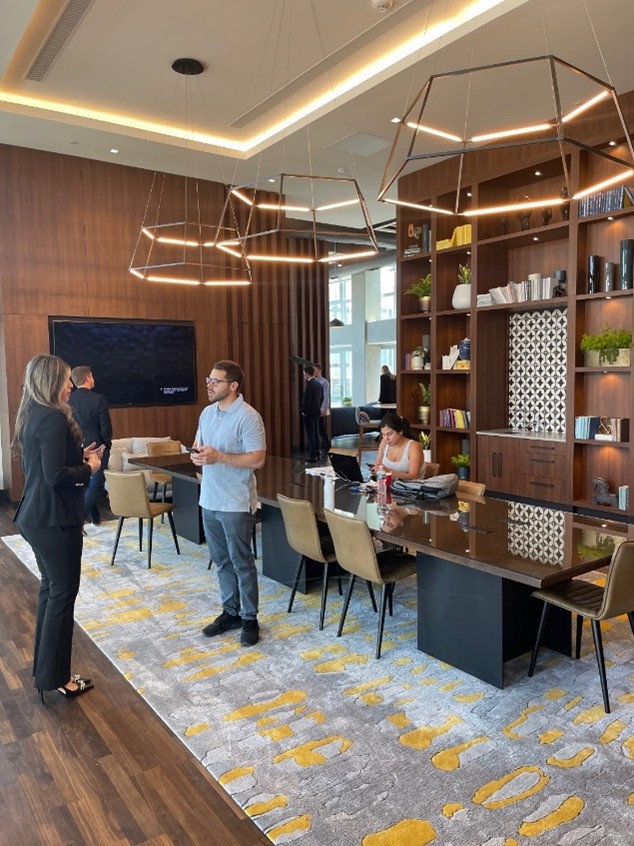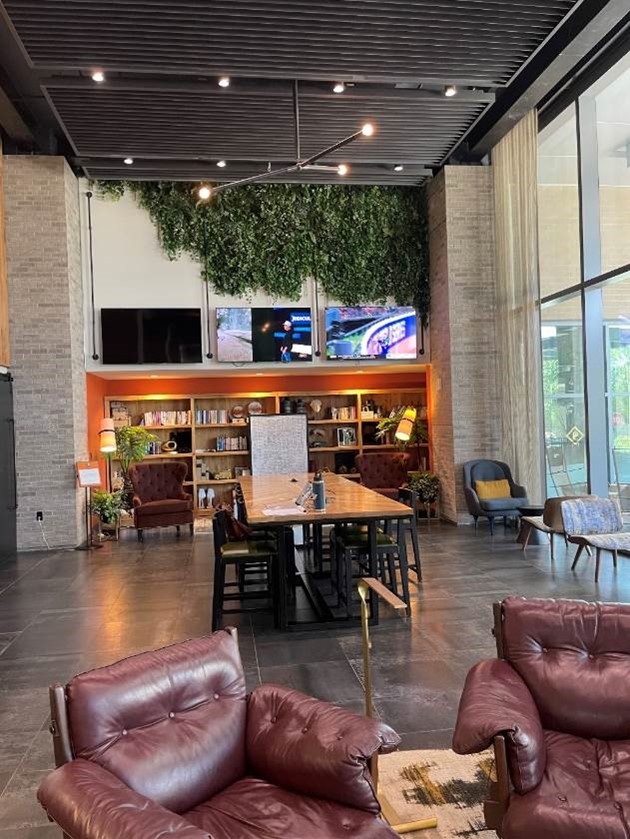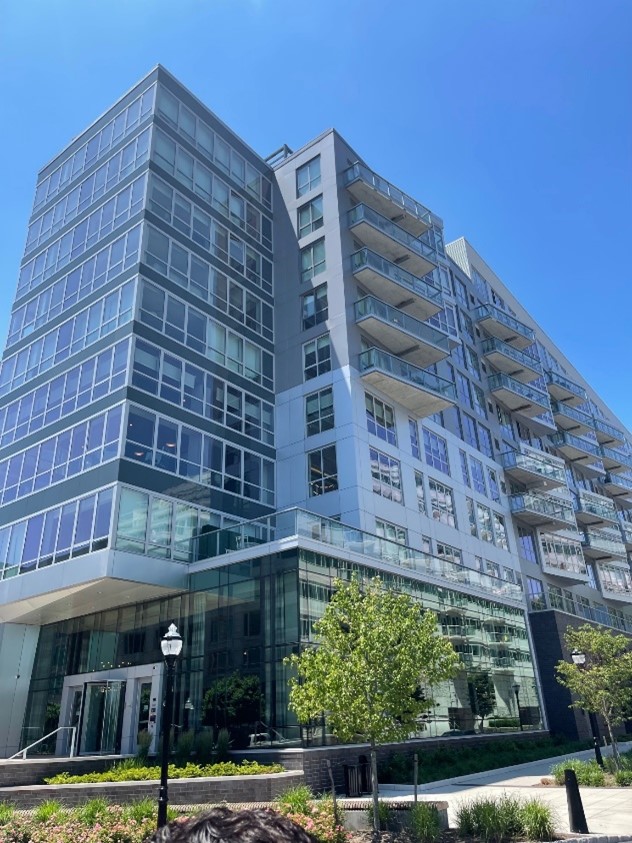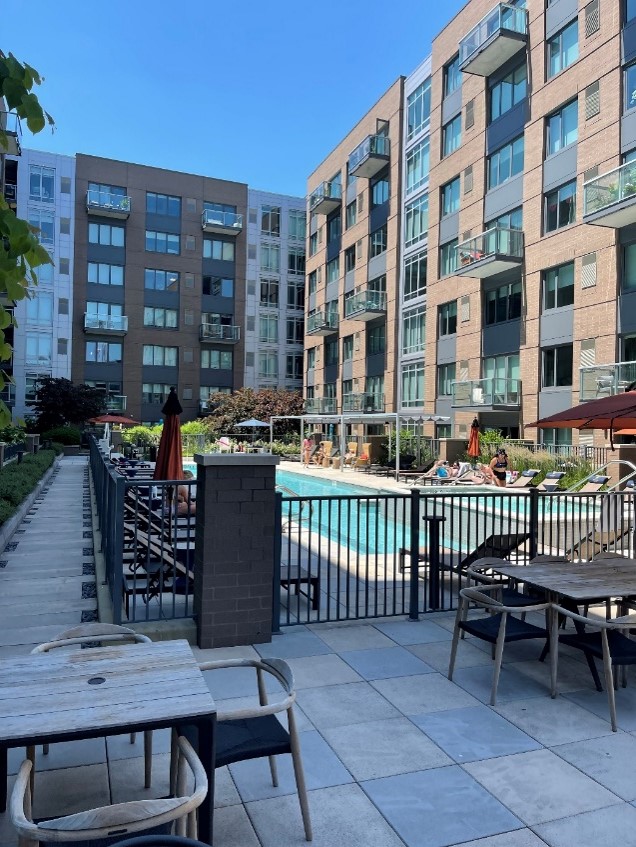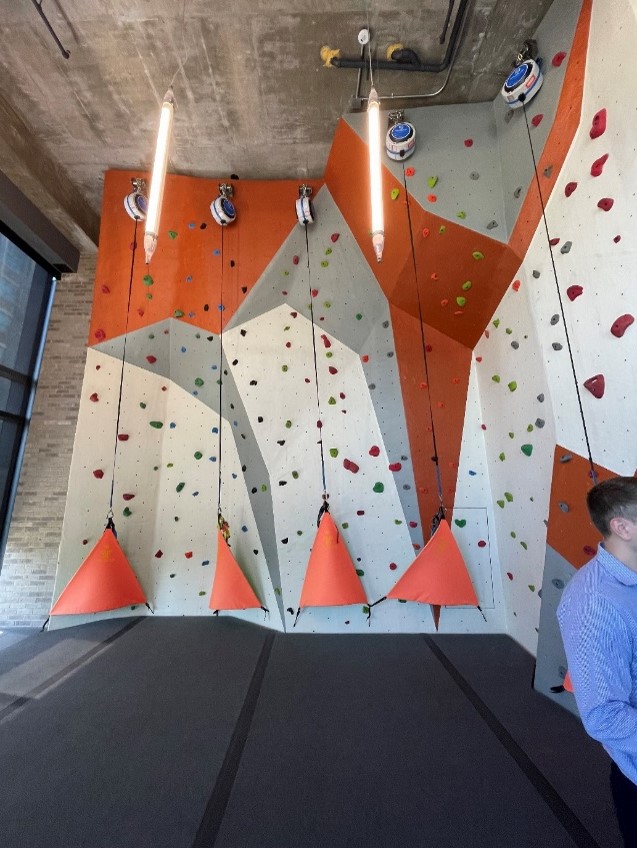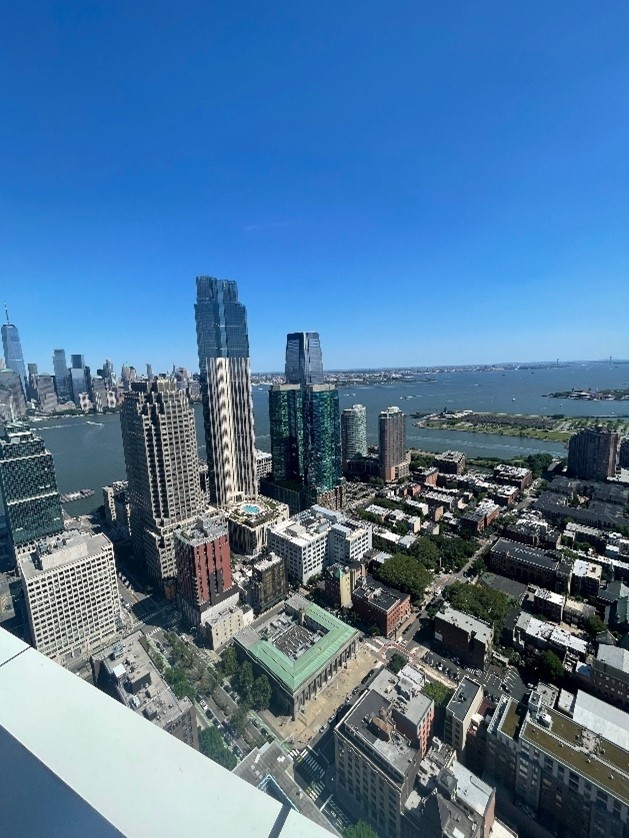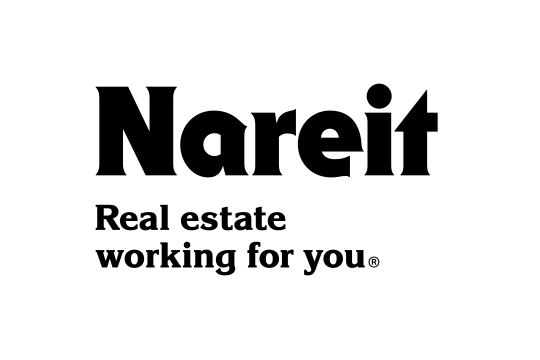We last visited NYC in November 2021 and this time stayed in Midtown which felt much busier. We had to stand in line at elevators for meetings, wait in queues to get lunch, and noticed that restaurants and stores were busy. Masks and proof of vaccination were not required anywhere, including in public transit or taxis. Compared to pre-Covid levels, subway ridership during the work week hovers around 59% and rises to 70% on the weekends.
Despite this, NYC office remains depressed as workers shun their long commutes for WFH. Only 8% of NYC office workers are in the office 5-days a week, and office utilization is at 41.2%, slightly below the national average of 44%. Tourism is expected to increase 70% YoY to 56.4m tourists in 2022, with approximately 8m coming from abroad. This is roughly 10m total tourists below 2019 levels.
Key Takeaways (strong fundamentals vs. bearish signals)
- When talking about fundamentals, management teams were broadly optimistic and touted strong operating metrics, a positive supply/demand picture, and record demand despite a volatile macro backdrop. The industrial, residential, gaming, retail, and senior housing sectors reported strong occupancy and pricing power. Office and skilled nursing REITs remained more cautious in their outlook due to tenant concerns or labour issues.
- We came away feeling management was too optimistic and complacent about quite how bad things could become if the macro situation continues to deteriorate.
- However, management teams do anticipate economic weakness and voiced recession concerns for the second half of 2022/early 2023, a notable change from the tone of Q1 earnings calls just a few weeks ago.
- As well as a rising cost of equity, management teams acknowledged that rising interest rates were also leading to increased borrowing costs, leading to a rising cost of capital and a pause in acquisitions and new developments as companies wait to see where interest rates will land. This is resulting in smaller levered private market players exiting markets. These factors, along with market uncertainty, are pushing up cap rates 20-50bps across REIT sectors. This could provide REITs with more accretive investment opportunities in the future. Discussions of private investors beginning to face negative leverage scenarios were mentioned for the first time.
- The flip side of less acquisition activity due to a less favourable cost of equity is that we should see more M&A with cash-rich buyers taking advantage of the cheap public markets. This is exactly what we have been seeing recently with USD 64bn of REIT M&A already announced in 2022, vs. the post-GFC annual average of USD 37bn.
- In discussions we had with other investors, it became clear most were looking for shelter in defensive sectors and now put a premium on the following characteristics:
- Companies in non-discretionary businesses (i.e., healthcare, grocery shopping centers) that would face limited demand headwinds during a potential slowdown
- Strong balance sheets exhibiting low net debt to EBITDA ratios, limited near-term debt maturities, and floating rate debt under 10%
- High dividend yields that have a positive spread to rising Treasury yields; gaming is such a sector (GLPI 6.3% div. yield) that has performed well YTD
- REITs that have already secured funding for the majority of their 2022 growth plans or can fund growth with dispositions as opposed to REITs that need to issue significant equity or debt
- REITs that can pass increasing inflationary expenses onto tenants; REITs with triple net leases or inflation rent step-ups built into leases are favored
- Sectors with improving labor backdrops. For example, senior housing operators are expecting a decrease in operator labor costs and have performed well YTD(-0.8%) while office workers still refuse to return, favor WFH, and face a slowing labor market (office -20.1% YTD)
- Short lease duration sectors (residential, hotels, storage, and industrial) generally provided positive operational updates, positioning them for 2Q beat/raises. However, this optimism hasn't necessarily been reflected in the share price in these sectors YTD. Hotels have performed the best in a tough market (-11.2% YTD) but residential (-19.2%), storage (-23.2%), and industrial (-32.3%) have underperformed. This is likely because these sectors performed well coming out of Covid and were trading at high multiples, which have compressed due to market volatility and lower growth assumptions. Conversely, it can be argued that these sectors have been oversold despite their continuing strong operating fundamentals, and this coupled with their short-duration leases, which help offset inflation, set up a situation for them to rally strongly in the second half of 2022 and early 2023.
Sector Takeaways
Retail, Malls, and Triple Net
We met with three retail and three retail triple net REITs. The overall theme was business remains good, especially the leasing environment for malls (Macerich) and shopping centers (Philip Edison, Regency).
Despite a potential recession and higher interest rates hurting the cost of capital, retail management teams were optimistic as foot traffic and tenant sales recovered to pre-Covid levels. Tenant store closings and credit watch lists were low, a function of covid killing the weak. Phillips Edison’s small retail format continues to provide high FFO growth, and Macerich continues to move its high-quality malls away from fashion and into mixed-use opportunities such as shared workspace and residential. EPR's improving movie theatre business is being driven by blockbuster movies such as “Top Gun: Maverick” and “Doctor Strange”. Realty Income continues to benefit from its scale, especially after its VREIT acquisition which we expect to increase FFO growth by c.17% in 2022.
Industrial
We met two Industrial REITs, Eastgroup (EGP) and Duke Realty (DRE). Both companies highlighted the strength of their business in key gateway markets such as Los Angeles and New York City. Both management teams said the Amazon slowdown was widely anticipated for some time and expect other companies such as Target and Walmart to increase their industrial exposure in a bid to catch up with Amazon. Despite strong rent growth (e.g., 10% for the last two years), EGP and DRE said rent is about 5% to 10% of supply chain cost, similar to other costs (e.g., fuel, labor, etc.) which have moved up faster than rent. See below for details on the tour of DRE’s New Jersey assets. Note, after this visit Prologis raised its acquisition exchange ratio for DRE by 2% to an implied EV of USD 23bn (all share deal) which was accepted by DRE’s board.
Cell Towers
American Tower (AMT) reiterated the strength of its domestic and international business as demand for new tower infrastructure is strong and supported by carrier CAPEX. Europe is doing well and management continues to look for acquisition opportunities on the continent. In addition, India's negative growth after a painful market consolidation is over. AMT is cautious about India due to its political uncertainties but notes its huge demand for tower infrastructure. Management remains positive on 5G and expects a higher average growth level than in the past. We remain positive on towers but favour SBAC over AMT due to SBACs higher exposure to the US 5G market.
Healthcare
Healthcare REIT share prices were battered during Covid but have begun to improve as their non-discretionary defensive characteristics become more valued in a volatile market.
REITs focused on senior housing operating portfolio (SHOP) and medical operating buildings (MOBs) were extremely upbeat while those with greater skilled nursing facilities still face headwinds. The largest SHOP operators, Welltower (+5.36%) and Ventas (+11.80%) are up YTD due to occupancy rising post-Covid with runway to grow and labor expenses falling as healthcare workers begin to return to the sector in greater numbers. MOBs are viewed as more predictable and defensive assets with low turnover and rent increases of 2-4% per year. Skilled nursing facilities are higher on the patient acuity scale and involve significant government intervention and still face significant labor pressures as these jobs are seen as less desirable. Healthcare is still a highly operational business model, and the operators are diverse, fragmented, and not always business and margin savvy. Margins of 20-25% in the healthcare REIT sector are seen as high.
Timber
We attended presentations from timber REITs Weyerhaeuser Company and Rayonier Inc. Both REITs talked about the increasing importance of US southern timberlands in the global timber market and the corresponding rise in price; Southern US acreage used to sell at USD 1,800 an acre and now sells for USD 2,600 an acre. Rayonier has a large southern timberlands portfolio, owning 1.8m acres of land. Both REITs agreed that although single-family mortgage rates are rising and homebuilder stocks have been pummelled, they expect the housing market to remain strong over the next 5 years, due to the housing shortage in the US. This will keep demand and prices for lumber to build the homes at high levels as well. Russia and Belarus were major suppliers of timber to Europe and Japan before the invasion of Ukraine. Now, both consumer markets are looking for timber elsewhere and Weyerhaeuser is seeing an uptick in global demand for its products.
Residential
Many residential REITs released operating updates directly before NAREIT, with apartments, in particular, highlighting continued demand and pricing power with blended rate growth (avg. US asking rent increased +12.7% YoY) and occupancy remaining above 97% with limited turnover despite price increases.
Manufactured housing, single-family rental, and apartment REITs all faced questions surrounding how their portfolios would fare in an environment with mortgage rates rising above 6% and single-family housing demand cooling. While some acknowledged that cap rates were increasing (Tricon Residential noted 20bps) and asset values falling slightly, residential management teams were unanimous in pointing out that the US housing market is massively undersupplied (shortage of 4m single-family homes) and rising mortgage rates would put homeownership out of reach for many Americans. They believe this would create more long-term renter demand, benefiting residential REITs.
We are the most bullish on manufactured housing in this sector due to its defensive nature in downturns, the growing institutionalization story, and steady state of 3-5% rent increases per year. Apartment performance has been tied to job and wage growth in the past and often performs more cyclically. In our meeting with UDR, they mentioned that some Sunbelt apartment markets such as Tampa were flashing oversupply warning signs for 2023, with supply coming online equalling 4-6% of total inventory. UDR reflected a sentiment heard in many other meetings; despite large rent increases loss-to-lease remains above 10%.
Gaming and Casinos
We had a small group meeting with Gaming and Leisure Properties (GLPI) and attended a VICI Properties presentation. Gaming REITs are down -3.3% YTD, significantly outperforming the index.
VICI is a large owner of Las Vegas casinos and talked about the strong numbers they are seeing out of Las Vegas as tourism picks up and conferences return. However, we currently prefer GLPI’s regional casino exposure which has proven more defensive during economic downturns (gamblers drive to GLPI casinos vs. fly to Vegas), and their core focus is on owning and operating casinos.
Since VICI purchased MGM Growth Properties for USD 17bn they have messaged to the market their hope to expand into non-gaming assets and become an “experiential REIT”. GLPI’s key drivers include the long-term expansion opportunities of their partnership with the Cordish family, some of the lowest CAPEX reserves and highest margins in the REIT space, improving performance and coverage of their key tenants including PENN gaming, and the further institutionalization and cap rate compression in the sector (Realty Income buying Boston casino for USD 1.7bn at 5.9% cap rate).
Office
While the sentiment around office remains negative and uncertain, REITs with the highest quality assets are widely perceived to be the best bet in a tough space. Despite Covid restrictions being lifted in the US and some WFH headline news (e.g., Elon Musk’s message to Tesla employees), office workers remain reluctant to return to the office, especially those with long commutes.
Nationwide utilization stands at 44%, with Sunbelt markets leading coastal, and the West Coast still lagging. In speaking to other investors or sell-side analysts at NAREIT, we learned that most office workers in NYC are in the office only three days a week, if at all.
We met with West Coast Class A office operator Kilroy Realty and would describe the sentiment of the usually upbeat management team as cautious despite announcing the recent leasing of 190k sqft of office space. Kilroy decided to halt plans for their Santa Fe office development in San Diego because of market and leasing uncertainty. Several of Kilroy’s tech tenants (Salesforce, Netflix) have announced hiring freezes, and there is investor consternation about whether a slowdown will lead to office firings. Kilroy management posited that a slowdown or recession would give leverage back to employers in the WFH debate and increase utilization and demand, but we believe this gain would be more than offset by a slowdown in office leasing demand which often occurs during economic slowdowns.
Interesting REIT Meetings
Ventas Inc. (VTR) - Healthcare
We attended a small group meeting with VTR CEO, Debra Cafaro. VTR is an S&P 500 company that owns and operates 1,200 properties in the U.S, Canada, and the UK. VTR has a diverse healthcare portfolio consisting primarily of senior housing communities but also on-campus life-science and medical office buildings.
Debra spent most of her time discussing senior housing and explained that a decrease in supply along with a surge in post-Covid demand from a rapidly growing senior population led the senior housing operating portfolio (SHOP) occupancy to increase 400bps YoY in 1Q22 and 80bps sequentially. Occupancy is 82% across the portfolio and Debra believes the supply/demand interplay could lead to occupancy eventually reaching 90%, a significant catalyst for the stock. Healthcare is a highly operational business (20-30% NOI margins) and VTR contended with rising labor costs in 2021, which hurt the stock. Debra noted labor pressure is now easing because of a combination of strategic hiring initiatives and workers returning to the healthcare space as Covid fears ease and personal savings rates decrease.
Farmland Partners Inc. (FPI) - Farmland
We had a one-on-one meeting with Paul Pittman, CEO, and founder of FPI. The company is the second-largest farming REIT in the United States. Gladstone Land (LAND) is the largest REIT with a market cap of USD 750m. Farmland is one of the largest commercial real estate sectors (c.USD 2.7 trillion) with the lowest institutional ownership.
FPI owns and manages 186k acres (equivalent to 75k hectares) across the United States with over 100 tenants and 25 crop types. Portfolio vacancy is 0%. FPI is internally managed, focused on commodity crops, more diversified locations, and limited water risk. LAND is externally managed, focuses on specialty crops (i.e., berries and almonds), and has a high California concentration with greater water risk. We find the supply/demand picture of farming attractive (growing population, less arable land for farming, etc.). Additionally, farmland is positively correlated with inflation. FPI's investment case is based on rising global food demand and land scarcity. FPI has a diversified crop portfolio but focuses on corn as it generates the most calories.
UMH Inc. (UMH) - Manufactured Housing
We had a one-on-one meeting with UMH, a pure-play manufactured housing REIT. We prodded them on execution risk to their 2022/2023 growth initiatives. The team was focused and confident in its ability to meet stated growth targets. Catalysts for the stock include:
- Obtaining 700 new manufactured homes from suppliers that are on backorder to add to their rental/home sales portfolio. In total 1,000 homes are on order for 2022 and 30% have been delivered. Supply chain issues have continued to cause delivery delays. Issues obtaining ordered homes was one of the reasons UMH missed FFO expectations in 1Q22. Sourcing the 700 homes is key to FFO growth expectations as it grows the portfolio by 8%, and proves to the market that UMH can execute on its stated goal to add 800 homes per year.
- Using cash on hand to retire the 6.125% Series C preferred by July will increase FFO/share by USD 0.08. Retiring the 6.375% Series D preferred at the beginning of 2023, ideally with the USD 50m securities portfolio.
- Steady and predictable 4% rental raises per year.
- Focus on developing 400 new rental sites per year for the next 5 years.
Duke Property Tour (DRE) - Logistics
We met Duke's senior team in the New Jersey (NJ) market and spent the day touring five of its key assets near NYC.
Tenants include Amazon, Blue Apron, and Kelco. Duke has 22 properties in NJ which accounts for 11% of its NOI and 13% of gross asset value. The assets are 100% leased and occupied. The market for class A properties is very tight and supply is low. Most of Duke's NJ assets are in the submarket next to the turnpike, which provides excellent access into NYC. In addition, the assets are close to the airport and harbor. Land prices (tripled in last six years) outpacing rent growth. Rent remains only about 5% of total cost as compared to other supply chain costs which have risen sharply (construction cost up 50% in last 2 years). We noticed the lack of class A buildings available in NJ. We expect this market to remain extremely attractive with high rent growth.
Veris Residential Property Tour (VRE) - Office and Multifamily
We toured VRE’s Jersey City residential assets with the management team. Veris Residential, previously named Mack-Cali, is in an ongoing transformation from a diversified office, hotel, and residential REIT to a pure-play Class A residential REIT with assets primarily in Jersey City directly across the Hudson River from the Manhattan skyline.
VRE’s 7,441 apartment units are on average the youngest in the apartment space (6 years), command the highest rents (USD 3,103 per unit),and have the lowest CAPEX reserve per home (USD 1,025). The apartments we saw were high quality and the VRE apartment portfolio is 97.2% occupied with blended lease growth of 16%. However, this turnaround story centers around the remaining assets that VRE plans to sell including five large office buildings on the waterfront in Jersey City which they value at USD 1bn, two waterfront hotels, and a large, ideally placed and entitled, land bank surrounding their current residential assets. The office assets are poorly leased (71.8%) but in a prime location with excellent views of the Manhattan skyline and quick access to the train that can take passengers across the river to Manhattan in 10 minutes. This is an interesting story with considerable upside (Green Street calculates VRE M&A takeout probability at 50%) but bears significant execution risk and balance sheet risk in a less benign transaction market. The CEO of VRE, Mahbod Nia, presents well and previously oversaw a European REIT, NorthStar, as it increased its NAV by 40% before being purchased by Bow Street LLC for a 10% premium to share price in 2016.
